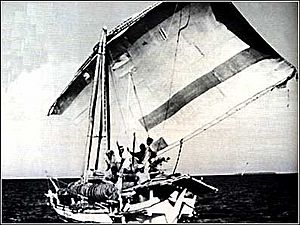Trepanging facts for kids
Trepanging is all about collecting or harvesting sea cucumbers. These sea creatures are known as trepang in Indonesia and Malaysia. People collect them mainly to use as food.
Someone who collects trepang is called a trepanger.
Collecting sea cucumbers is a bit like other types of fishing where people gather animals without backbones, like clams, crabs, lobsters, mussels, or shrimp. The main goal is to find edible creatures, not just fish.
A Look Back in Time
For a long time, people from Makassar (in what is now Indonesia) collected sea cucumbers. They traded with the Aboriginal Australians in Arnhem Land. This started at least in the 1700s, or maybe even earlier!
This meeting between the Makassarese and Aboriginal Australians was the first time people from the Australian continent had recorded contact with their Asian neighbors.
This contact had a big impact on the Aboriginal people. The Makassarese traded things like cloth, tobacco, knives, rice, and even alcohol. In return, they were allowed to collect sea cucumbers along the coast. They also hired local people to help them. A special language, called Makassar pidgin, became a common way for different Aboriginal groups to talk to each other. This happened because the Makassarese sailors brought them closer together.
Even today, you can find signs of this contact. There are old trepang processing sites from the 1700s and 1800s at places like Port Essington and Groote Eylandt in Australia. You can also see tamarind trees that the Makassarese planted. These trees originally came from Madagascar and East Africa.
How Are Sea Cucumbers Collected?
Sea cucumbers move slowly and live on the sea floor. They are related to sea stars and sea urchins.
Because of where they live, trepangers collect them in different ways:
- They might use a spear.
- They can go diving to pick them up.
- Sometimes, they use a special tool called a dredge.
- When the tide is low, sea cucumbers are sometimes exposed, so people can just pick them up by hand.
In the past, after collecting them, sea cucumbers were put in boiling water. Then, they were dried and smoked before being sold at markets.
Why Are Sea Cucumbers Important?
Collecting sea cucumbers is a very important economic activity in some parts of the world, especially in Southeast Asia. Sea cucumbers are seen as a special food in countries like Malaysia, China, Japan, and Indonesia.
People value sea cucumbers not just for their taste, but also because many believe they are a stimulant. There is even some scientific proof that their supposed medicinal properties might be real.
Because of the belief in their healing powers, medicine and cosmetics companies have made products like pills, oils, and creams using extracts from sea cucumbers. Scientists have even studied how well sea cucumber extract can help with tissue repair.



